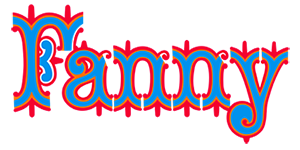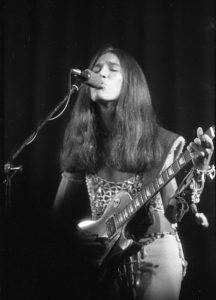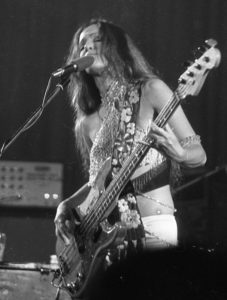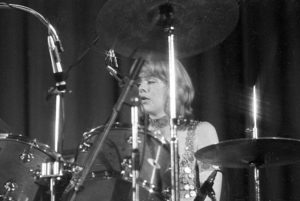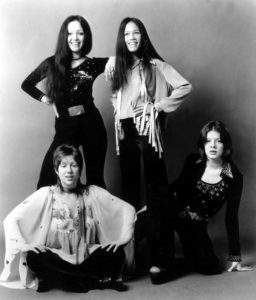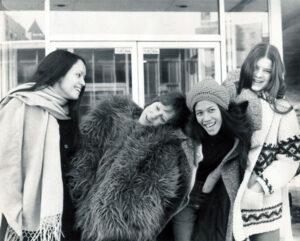
FANNY was a truly pioneering rock band, the first of its kind. Their career broke down the barriers for female musicians in rock. In fact, they were pretty much the original “godmothers of women who rock”!
FANNY: four young women who were accomplished rock instrumentalists and singers… who never depended only on their sexuality to sell the music… who were self-described as being musicians first and women second. But the fact that they WERE women, and that they reached a level of success previously unheard of for a rock band composed solely of women, was a remarkable achievement.
FANNY was the first all-female rock act to record an entire album for a major record label, and in fact recorded and released five albums for major labels. FANNY was the first all-female rock act to rise to real prominence in the US and Europe. Acknowledged by both the press and their many fans as an awesome live act – in the words of Steve Peacock, a top UK music journalist of the era, “if you close your eyes, it’s like listening to the Stones” – FANNY toured tirelessly for up to nine months of every year. In a career that stretched from 1970 to 1975, they had a string of hit singles and also played on the studio recordings of some legendary artists. In addition to their many live gigs, they performed on top music and variety television shows of the time, including The Old Grey Whistle Test, the Sonny and Cher Show, American Bandstand and The Beat Club, Germany’s most famous band program.

The four original members of FANNY were June Millington (guitar, vocals), Jean Millington (bass, vocals), Alice de Buhr (drums, vocals), and Nickey Barclay (keyboards, vocals). June and Nickey were the primary songwriters for the band, but Jean and Alice made significant contributions to FANNY’s repertoire and all four participated in arranging the songs and crafting their stage performances. Some of the biggest music stars of the time, from David Bowie to Deep Purple to George Harrison to the Kinks, were so blown away by these four teenaged rockers that they went out of their way to promote the band and to book them as an opening act.
Despite their success, FANNY were never quite superstars, but they prepared the way for women in rock. When they started out, the idea of young women as rock players was as unthinkable as the idea of women having the vote had been to earlier generations. Recently, FANNY was finally honoured by receiving the ROCKRGRL WOMEN OF VALOR award for their vital achievement, and feted at Berklee College of Music on April 20, 2007 with a gala evening including testimonials and a “rockestra” of Berklee students playing FANNY’s songs.
FANNY: a legend whose legacy lives on in the women rock musicians of today.
This is their story…
Sisters June and Jean Millington, Philippines-born daughters of an American naval officer and a Filipina socialite, moved with their family to Sacramento, California in 1961. Surrounded by strangers in an unfamiliar country, they took up music to keep their spirits up and performed in high school, first as a duo with June on guitar and Jean on bass and then forming an all-female quartet, The Svelts. Their first drummer was friend Brie Berry, who dropped out of the band to have a baby (but eventually returned to music as Brie Brandt and joined FANNY in the late stages of their history).
The Svelts played in clubs up and down the West Coast and in Nevada. After a number of personnel changes, Jean and June were joined in 1968 by guitarist Addie Clement (from the band California Girls) and drummer Alice de Buhr, a native of Mason City, Iowa who had moved to California at the age of seventeen in search of the proverbial fame and fortune. In this four-piece configuration, the Svelts gigged around the West in a renovated city bus, mainly playing covers.
Later that year, Alice and Addie left the Svelts to found another all-female band, Wild Honey, and gigged briefly in the Midwest before returning to California to rejoin the Millingtons. As Wild Honey, now playing Motown covers, they headed to LA in 1969 to “either sign with a label or go back to school.” It was very nearly the latter – no one in the Hollywood music industry took them seriously, and after a while Wild Honey were ready to give up and head home. But on what they thought would be their final night in LA, they played an open mic night at Doug Weston’s famous Troubadour Club, and by chance Richard Perry’s secretary was there checking out unsigned bands.
Perry, a Warner Brothers Records staff member and leading producer with a list of hits to his credit (Leo Sayer, Carly Simon, Barbra Streisand, etc.), had always dreamed of discovering a band of young women who could rock out powerfully, and once Wild Honey had auditioned for him he lost no time in convincing WB head honcho Mo Ostin to sign them. In fact, Perry was so sure of Wild Honey’s potential that he got the band signed to WB subsidiary Reprise Records sight unseen – and sound unheard! Wild Honey, now a three-piece (Jean, June and Alice), went into Western Recorders with Perry in December 1969 to work on their first album of original songs. After a number of tracks were recorded, though, both band and producer felt that there was something missing – namely, a keyboard player.
Finding a good rocking keyboardist who was also young and female was no easy task back in 1969, when most young girls were more likely to sit politely at the piano instead of playing in a rock band. Wild Honey flew in prospective keyboard players from as far away as Nashville and even Canada, but no one met all the criteria until they found Nickey Barclay, a young but experienced professional session player who was a charter member of Sterling Haug’s LA-based Musicians Contact Service.
There was only one hitch – Nickey had only ever worked with male musicians and wasn’t at all interested in joining an all-female band. As Nickey said in a 1974 interview*, “They were excited about the way I played, they really liked it. But I was put off. I guess I was used to being the only girl in the group… They seemed to have a real friendship and an understanding like bands have, but I’d never seen that with girls. They had to get back in touch with me because I didn’t call them…”
Nickey became the fourth member in January 1970 and immediately began recording with Wild Honey, bringing in her blues-soul-funk background to give the band’s sound a harder edge. But she left for several months to tour as a member of Joe Cocker’s soon-to-be-legendary Mad Dogs and Englishmen, appearing on the hit live album and singles and in the Mad Dogs film. She returned hesitantly to Wild Honey after the tour – partly because Cocker convinced her it would be a good idea – and signed on formally as a band member, finishing the recording of what would be Fanny’s first album for Reprise.
After Nickey joined the band and the album release was imminent, the question of a new name was raised – by the four themselves, by Richard Perry, by their label and by their management, the Blue peacock Company. Everyone felt that what was needed was a woman’s name, something short, memorable and at once feminine and bold. After considering a series of suggestions the band settled on the name FANNY, and the rest was history. June would later explain, “We really didn’t think of [the name Fanny] as a butt, a sexual term. We felt it was like a woman’s spirit watching over us.”
Leading up to and following the band’s first (self-titled) LP release, Reprise Records wasted no time in exploiting the name through promotional photos and advertisements showing the women of FANNY from the back, and distributing bumper stickers urging record buyers to GET BEHIND FANNY, and a later advertising campaign proclaiming FANNY: THE END OF AN ERA. “Both slogans were my doing,” Nickey has said. “I suggested them as a joke, but [manager Roy] Silver and the label took them seriously and ran with them. They certainly got people’s attention… I was also playing on the different slang meanings of the term fanny in America and the UK.”
The band had already attracted serious notice in LA even prior to the release of their first album. As one of the favorite local bands at the Whisky-a-Go-Go, they were booked there so often that it was effectively a residency for them. Fellow musicians and scene-makers including George Harrison, David Bowie, Deep Purple, the Rolling Stones, the Who, the Kinks, Rod Stewart, Ringo Starr, Harry Nilsson, Rodney Bingenheimer and Kim Fowley admired Fanny and helped promote the band by word of mouth at the top levels of the music industry, but the public would be slower to “get behind” the band.
While the band’s first album release, FANNY, was groundbreaking in that every note on the album was sung and played by women, the rock press was generally less than impressed. Fanny was mistakenly seen as more of a novelty act than as serious musicians with something to say. One reviewer wrote that the band was “trying too hard.” Fanny was blazing a trail, but most reviewers had no reference point, no basis of comparison for judging a group of women playing rock music.
Fanny would have to become that reference point.
In England, where the word “fanny” is a slang term for a woman’s vagina, the band were hailed as outrageous feminists. But the members of FANNY did not necessarily consider themselves to be feminists, at least not in the early days; they were musicians first and women second, dressing more like the guys, fighting to gain credibility in a man’s medium. Nickey Barclay later talked about the band’s physical image: “We did feel the pressure of having to prove ourselves. When we first started performing, we just went on stage wearing whatever we were wearing. It amounted to us apologizing for being women, shying away from any kind of glamour or attractiveness on stage.” The band’s look became more feminine and stylish once they had proved themselves through the hard grind of international touring.
FANNY’s second offering, 1971’s CHARITY BALL, received a much warmer reception from the rock press, with the LP even eliciting some predictions of superstardom. The title track hit the singles charts in the US, peaking at number 40 on the Billboard singles charts in November, and FANNY toured extensively to support the breakthrough. Thousands of punters on several continents came to laugh at what was expected to be a “freak show” and came away as true believers. The band was given further credibility through becoming the favored support act of a number of the biggest bands of the era, but at the same time they became headliners in their own right at large concert venues.
Prior to the arrival of Fanny, no all-female band in any genre of modern music, playing their own instruments and writing most all of their own material, had ever known true success; Fanny was the first. And in the music business – then as now – success breeds imitation. Other labels saw a new market niche to exploit and began promoting all-female bands. If one wishes to point to any one moment in time when the doors were truly kicked opened for female rock bands, one need look no further than the release of FANNY HILL, Fanny’s third LP in 1972.
FANNY HILL, recorded at the Beatles’ Apple Studios in London, was hailed by the leading rock press of the day as being their best yet. The album features some of the band’s finest studio moments and showed the musical maturity of what was now several years of recording and touring; when Rhino Records decided to release a FANNY retrospective CD set in 2002, they tellingly named the collection FIRST TIME IN A LONG TIME, after one of the most memorable tracks on FANNY HILL.
By now FANNY was a name to conjure with. They were no longer a laughing stock but were acknowledged and admired as a serious rock band. They even passed the rock-cred “test of fire” by having one of their singles, Young and Dumb, banned by BBC Radio 1 (and by being banned from playing live at the Albert Hall – for being “too provocative”!). They continued to tour almost constantly throughout North America and Europe, stopping only to record yet another album, their second release in ten months. Todd Rundgren replaced Richard Perry as producer on FANNY’s fourth album, 1973’s MOTHER’S PRIDE, which is probably the band’s “hardest” rock LP and was also the only one of their five albums not to feature a band photo on the cover. “Working with Todd was far more soul-satisfying than working with Richard [Perry] ever was,” Nickey said. “He treated us with much more respect and gave us our heads more when it came to creative input and production.”
The women of FANNY were coming to terms with, and learning to balance, their roles as both women and rock musicians, but the strain was beginning to take its toll within the band. Shortly after the release of their fourth album, FANNY collapsed temporarily as a result of what writer Barbara O’Dair** called “internal tensions, accumulated strains, and the ordinary occupational hazards of making it in a man’s world predicated on sex, drugs and rock and roll.” In the wake of increasing discord, Alice and June left the group one by one. June was replaced on lead guitar and vocals by Patti Quatro, big sister of pop sensation Suzi; Alice was replaced on drums by former Svelte Brie Brandt. Nickey and Jean elected to stay on, and it was this line-up which recorded the final FANNY album, ROCK AND ROLL SURVIVORS. Having completed their deal with Reprise Records, ROCK AND ROLL SURVIVORS saw the band move to Casablanca Records – home of several huge ’70s acts including Donna Summer, KISS, Parliament and the Village People – and take on a new producer, Vini Poncia.
ROCK AND ROLL SURVIVORS would turn out to be the band’s final effort. It included the single Butter Boy, which peaked at number 29 on the Billboard singles charts in February, 1975, but by the time the single became a hit there was no band left to promote it.
In late 1974, Nickey left Fanny. From all accounts, the band was moving in a direction that Nickey wasn’t happy with; she found Patti Quatro an unsatisfactory replacement for June, and her ultimate feeling was that, without June and Alice, it just wasn’t FANNY any longer. Cam Davis, a friend of June’s, was brought in to replace Brie on drums when Brie left to marry composer James Newton Howard at the end of the ROCK AND ROLL SURVIVORS sessions. Having never recorded with the band, Cam tended to defer to the others.
Patti began to assume a leadership and decision-making role within Fanny, a situation which Jean resented due to having been involved with the band from its very beginnings. Things came to a head in early 1975: Cam left, with Patti following shortly thereafter. As this happened when Butter Boy was climbing rapidly up the national charts, and Jean was especially disheartened – Fanny was shaping up to have their biggest hit ever and there was no band to help push it along.
In the spring of 1975, Jean convinced June to come back for one more tour, and Brie Brandt-Howard also agreed to sign on. The band was rounded out by Patti Macheta (a friend of June’s) on percussion and vocals and Wendy Haas, wife of Martin Mull and an old friend of the original FANNY band members, on keyboards and vocals. But although they ostensibly got back together to promote Butter Boy, they didn’t perform any of FANNY’s material – one of June’s conditions for coming back was that the band do only new songs. They also discontinued any use of the name FANNY, instead billing themselves as the L.A. All-Stars. By early 1976 a number of labels were expressing interest in financing an album; however, label interest was strictly focused on a continuation of the FANNY legacy and name. The L.A. All-Stars came within a hair of inking a deal with Arista Records, but ultimately, the label demanded non-negotiably that the women again call themselves FANNY, and June refused to sign on for another tour.
FANNY’s career had come to an end, but the legacy of their pioneering efforts for women in rock lives on to this day. The many fans who saw FANNY play live knew, and still remember, that they rocked harder on stage than most of their male-produced recorded tracks suggested. It’s not an overstatement to say that all the female movers and shakers in the rock world, from Joan Jett to Courtney Love and onwards, owe a debt of gratitude to FANNY for getting that all-important first foot in the door and showing the world that women can truly rock!
AFTER THE BALL…
David Bowie wrote about FANNY in Rolling Stone Magazine – 12/29/99:
“One of the most important female bands in American rock has been buried without a trace. And that is Fanny. They were one of the finest fucking rock bands of their time, in about 1973. They were extraordinary: They wrote everything, they played like motherfuckers, they were just colossal and wonderful, and nobody’s ever mentioned them. They’re as important as anybody else who’s ever been, ever; it just wasn’t their time. Revivify Fanny. And I will feel that my work is done.”
That endorsement of FANNY says it all.
